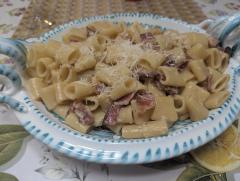 This is my favorite of the Four Classic Roman Pasta Dishes. It's essentially a Pasta Cacio e Pepe in which you first fry up a batch of chopped guanciale and stir the pasta into the bacon fat. Then you add the finely grated cheese like in the Cacio e Pepe to make the sauce. When you use top quality ingredients and good IGP pasta di Gragnano, it's simple and simply wonderful!
This is my favorite of the Four Classic Roman Pasta Dishes. It's essentially a Pasta Cacio e Pepe in which you first fry up a batch of chopped guanciale and stir the pasta into the bacon fat. Then you add the finely grated cheese like in the Cacio e Pepe to make the sauce. When you use top quality ingredients and good IGP pasta di Gragnano, it's simple and simply wonderful!
Rigatoni or other short, ribbed pasta is traditional for this dish. Shown here is Mezze Maniche from Pasta Somma in Gragnano.
